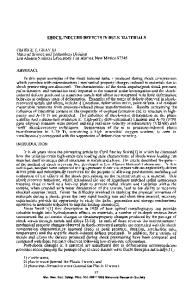Hydrogen-related defects in bulk ZnO
- PDF / 182,149 Bytes
- 5 Pages / 612 x 792 pts (letter) Page_size
- 91 Downloads / 378 Views
1167-O07-07
Hydrogen-related defects in bulk ZnO Matthew D. McCluskey,1 Slade J. Jokela,1 and Marianne C. Tarun1 1
Washington State University, Pullman, WA 99164-2814
ABSTRACT Zinc oxide (ZnO) has attracted resurgent interest as an active material for energy-efficient lighting applications. An optically transparent crystal, ZnO emits light in the blue-to-UV region of the spectrum. The efficiency of the emission is higher than more “conventional” materials such as GaN, making ZnO a strong candidate for solid-state white lighting. Despite its advantages, however, ZnO suffers from a major drawback: as grown, it contains a relatively high level of donors. These unwanted defects compensate acceptors or donate free electrons to the conduction band, thereby keeping the Fermi level in the upper half of the band gap. This paper reviews recent work on hydrogen donors and nitrogen-hydrogen complexes in ZnO.
INTRODUCTION Zinc oxide (ZnO) is an ‘old’ semiconductor that has attracted resurgent interest as an electronic material for numerous applications [1]. A wide-bandgap (Eg ~ 3.4 eV) semiconductor, ZnO emits light in the blue-to-UV region of the spectrum. The high efficiency of the emission [2] makes ZnO a strong candidate for solid-state white lighting. ZnO is currently used as a transparent conductor [3] in solar cells [4]. It is also a UV-absorbing material in sunscreens [5] and the active material in varistors [6]. ZnO is preferred material for transparent transistors, devices that could be incorporated in products such as liquid-crystal displays [7]. ZnO has practical benefits that make it an attractive material from an industrial point of view. In contrast to GaN, large single crystals can be grown relatively easily [8]. The environmental impact and toxicity are lower than most other semiconductors - ZnO is actually used as a dietary supplement in animal feed [9]. The low cost of zinc as compared to indium make it economically competitive for transparent conductor applications. For ZnO to reach its potential, however, the role of donor defects must be understood. One such defect is hydrogen, a common impurity in ZnO. We have studied hydrogen donors using infrared (IR) spectroscopy and Hall-effect measurements [10,11]. One donor species results in an IR absorption peak corresponding to O-H bond-stretching vibrations. This species is unstable, decaying in a few weeks at room temperature. By correlating the free-electron concentration with the IR absorption strength, we established that hydrogen acts as a shallow donor. Novel schemes for introducing acceptor dopants must be investigated if ZnO-based devices are to become technologically and economically feasible. Toward that end, we formed nitrogenhydrogen (N-H) complexes in ZnO during chemical vapor transport (CVT) growth, using
ammonia as an ambient [12]. The N-H bond-stretching mode gives rise to an IR absorption peak at 3150.6 cm-1. Isotopic substitutions for hydrogen and nitrogen result in the expected frequency shifts, thereby providing an unambiguous identifica
Data Loading...









